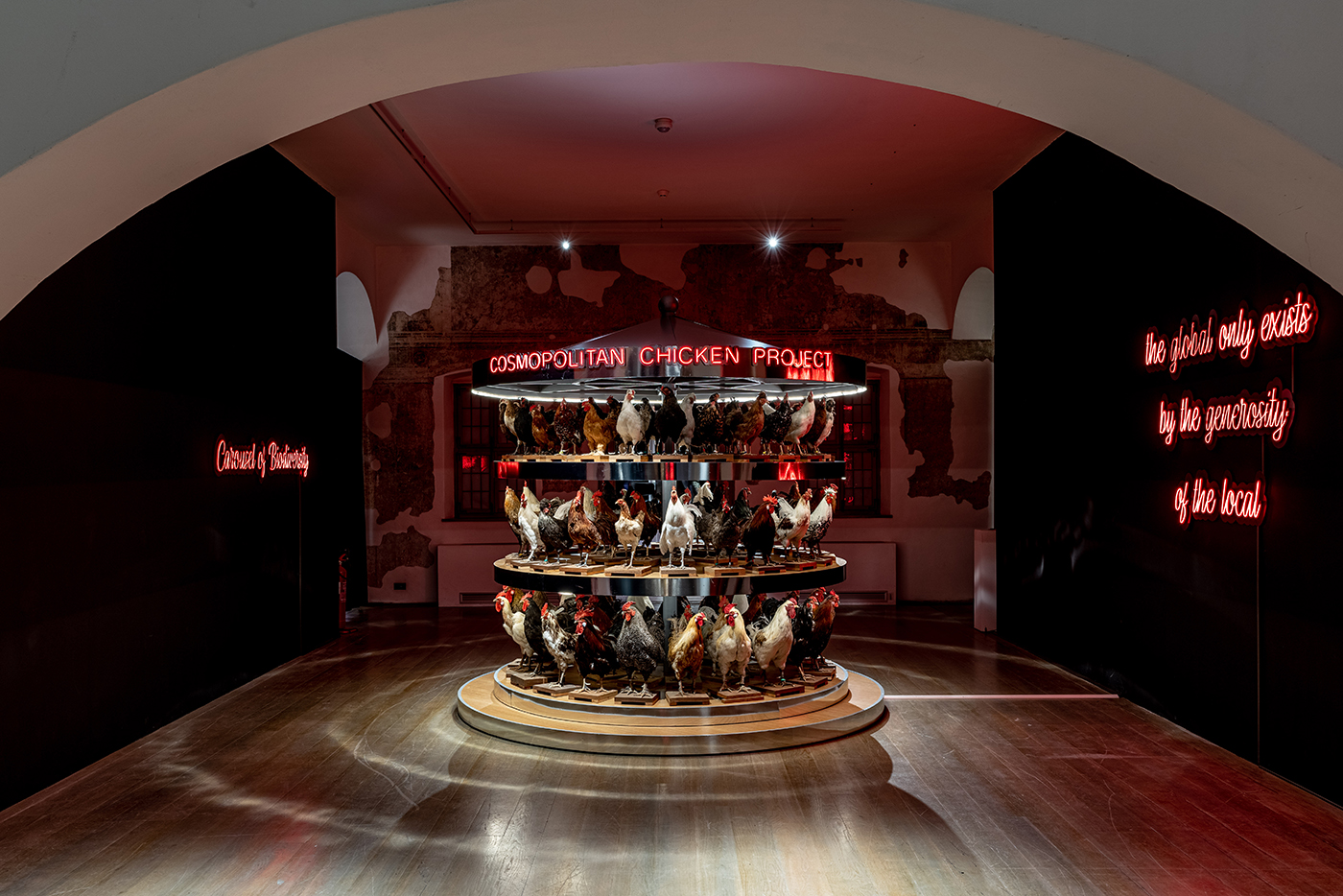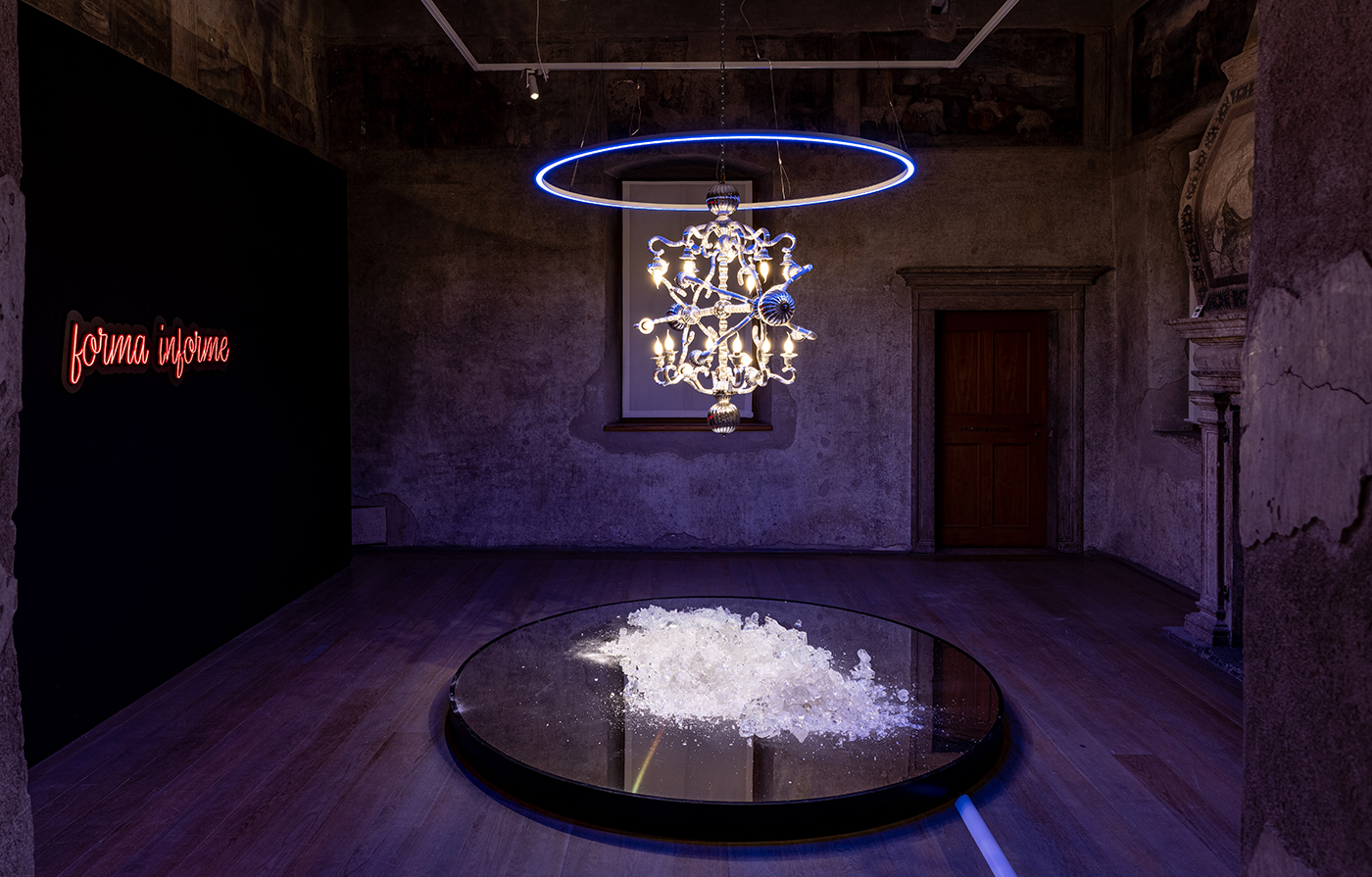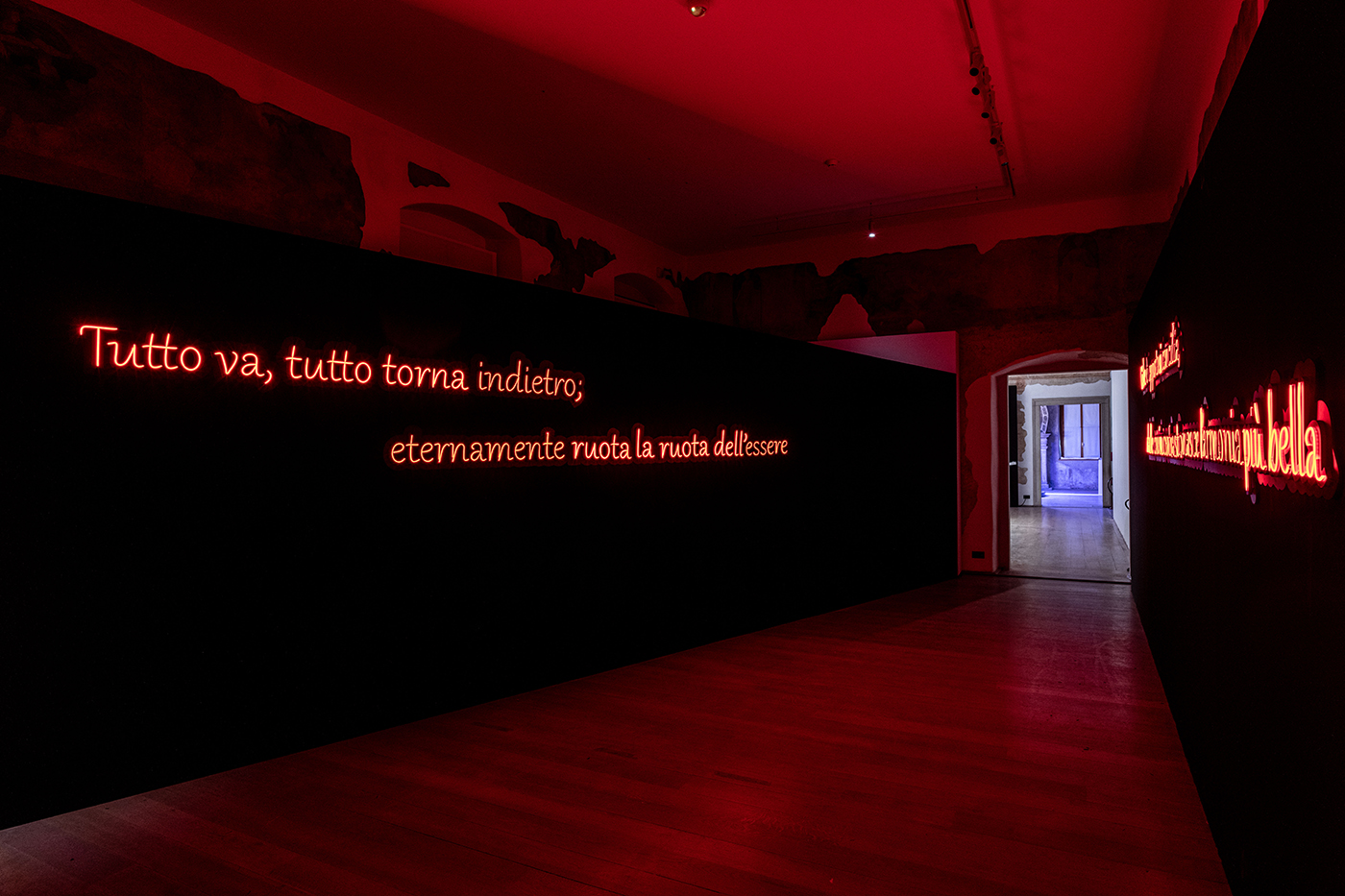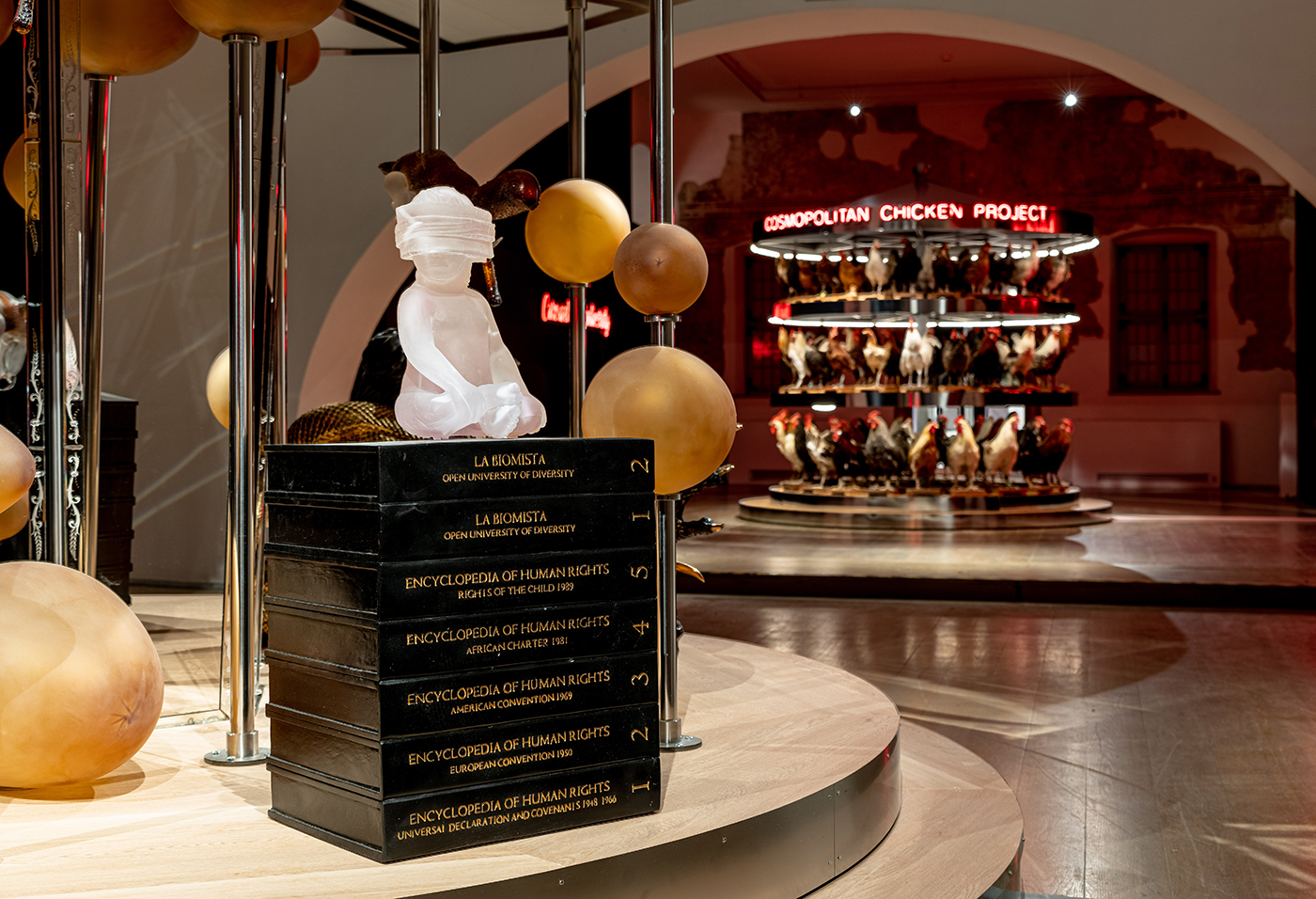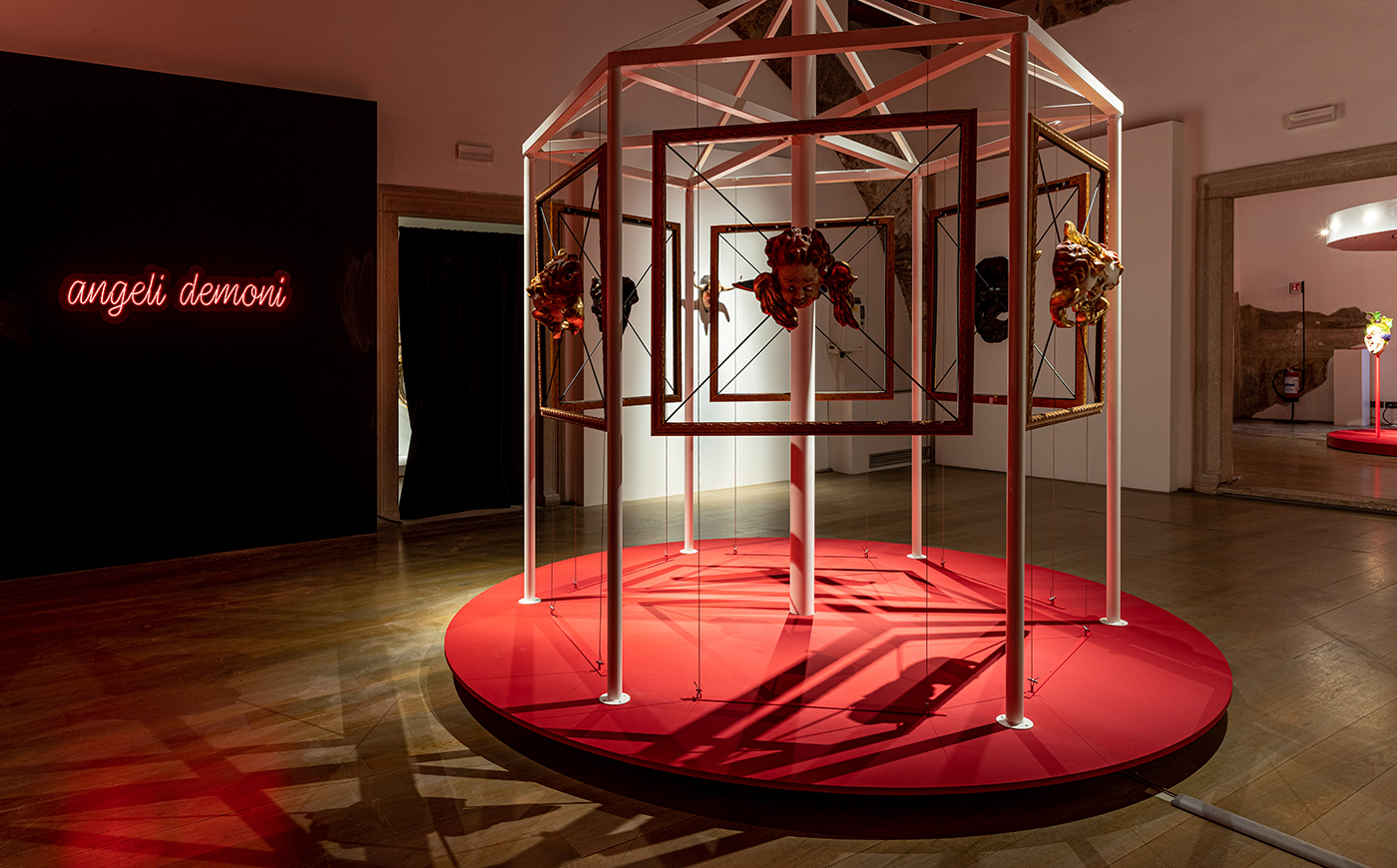by Alexandra MAS
Have we, perhaps, unwittingly severed the connection between ourselves and Mother Nature, leaving us vulnerable to the very demise we have imposed upon lifeless entities? Have we completely forgotten the primordial knowledge?
In a world increasingly dominated by consumerism and an unrelenting pursuit of progress, it becomes imperative to question the essence of our relationship with the environment. “Anima Mundi, the carousel of life” is an immersive experience held within the mythical spaces of Palazzo Delle Albere, part of the science museum in Trento, Italy. Art and science converge here in harmonious poetics, reminding us of the point at which we lost sight of the intrinsic value and interconnectedness of all living things. imagined by Stefano Zecchi and curated by Beatrice Mosca, the exhibition brings together conceptual artists, master artisans, designers, scientists, and art collectives to showcase the inherent beauty and vitality that permeate every facet of existence.
As we witness the repercussions of our actions, it becomes evident that our ecological fears are a manifestation of a deeper truth: a yearning to reignite that soulful bond and restore harmony between humanity and the natural world. It serves as a poignant reminder that our choices and actions carry consequences, not only for the external environment but also for our own well-being and the very essence of our collective humanity.
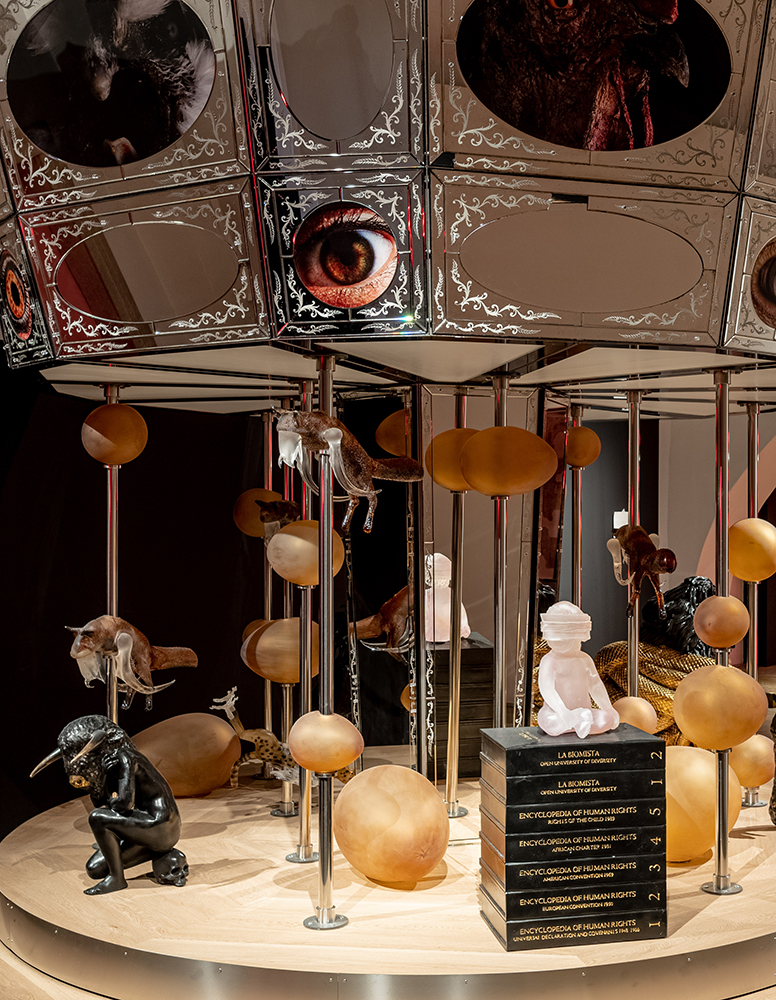
In the pursuit of progress and convenience, we have inadvertently distanced ourselves from the soul that infuses life into our surroundings. We have become disconnected from the intrinsic value and sacredness of the natural world. This disconnection is at the core of our ecological anxieties—a stark reminder that we cannot separate ourselves from the intricate web of life.
To reestablish a positive relationship with the world, we must reawaken our awareness of the profound interdependence and interconnectivity that defines our existence. We must strive to infuse our actions with compassion, respect, and a deep reverence for all forms of life. By embracing a holistic perspective, we can foster a renewed sense of harmony and ensure a sustainable future for generations to come.
the artists
Koen Vanmechelen / Sebastian Brajkovic / Marta Klonowska /
Marcello Pietrantoni / Sergio Boldrin
BERENGO STUDIO and FONDAZIONE BERENGO
“A exhibition between Art and Life – says curator Beatrice Mosca – where the invited artists express a completely original form of expression. Sculptors, painters, artisans, glassmakers, cabinetmakers, mask makers, in their works, matter and soul merge, transforming and returning to themselves. Life and art intertwine and exchange steps, like in a continuous dance, now one creates the artwork, now another shapes reality in the invisible forms of the cosmos. The physical world becomes the enigma to unveil, representation transcends it to investigate its eternal secret.”
Anima mundi, the soul of the world, is an expression that can be traced back to ancient Eastern philosophies, animistic religions, and a polytheism where the deities are distant emanations of the spirit. Our culture reserves an important place for reflection on the concept of the soul of the world, from the origins of Western thought to modern times. Plato (428 BCE–347 BCE), in his dialogue Timaeus, which discusses the structure of existence, explains the origin of the cosmos through the work of the Demiurge who shapes and orders a pure chaotic matter in the image and likeness of the world of ideas. Plato believes that the Demiurge has infused every visible form with a soul, like a spark that gives life and energy to lifeless things. The soul of the world, in its simplest and most immediate sense, means the world infused with soul: life in nature, in humans, and in what they create. This concept, originating from Plato’s dialogue, begins its long journey in our culture. The Stoic philosophers (Chrysippus 276 BCE–204 BCE, Seneca 4 BCE–65 CE, Marcus Aurelius 121–180 CE, to name a few) identified God with the world and conceived of this union as an “immortal animal,” rational, perfect, intelligent, and blissful, attributing an even more universal characteristic to the soul of the world than Plato. However, it was with Plotinus (204 CE–270 CE) that the soul of the world would receive its most organic definition, influencing Renaissance culture up to the great German Romanticism. According to Plotinus, the soul of the world is the second emanation of the One or God and proceeds from the Intellect, which is the first emanation. Therefore, it maintains a close relationship between the ideas of the intellect and the lower things, abstract concepts and material reality. In contrast to the mechanistic conception of the world, which claimed that organic forms were the result of the combination of several parts that coincidentally came together and added up – theories that found their most important interpreter in Democritus (460 BCE–370 BCE) in Greek philosophy – Plotinus, the most prominent figure of Neoplatonism, believed that organisms were not a random agglomeration of parts, but that their formation depended on a unified intelligent principle: the very principle from which plants, animals, and humans take shape. The soul of the world is a unified, universal foundation that gives life and movement to the world-reality: death lies in wait in things when they are believed to be lifeless, without soul, matter among inert matters.
Stefano Zecchi
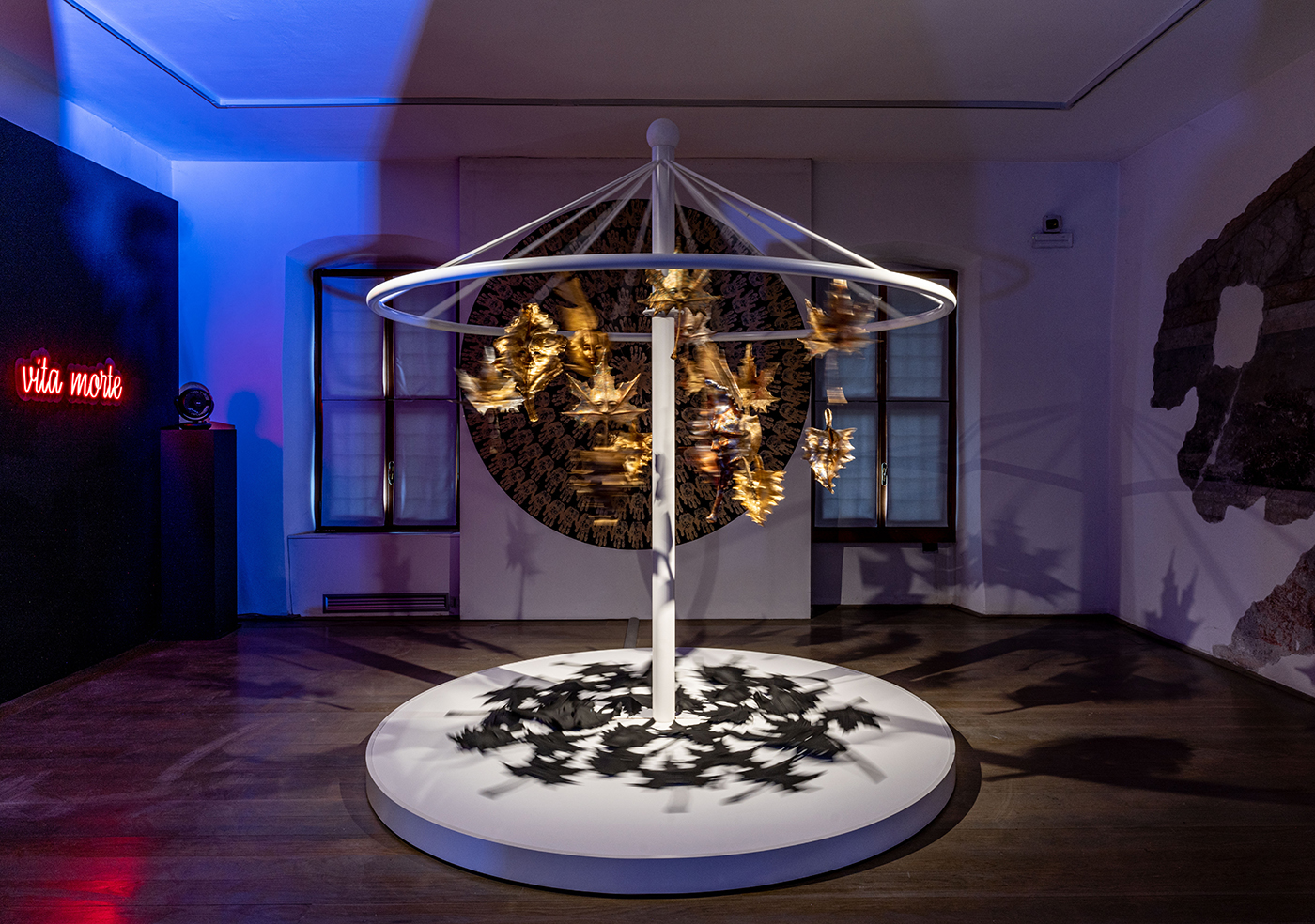
Let us heed the call to restore the soulful essence to our interactions with the world. Let us recognize that our ecological fears are a powerful catalyst for change, urging us to rediscover our intrinsic connection to the intricate tapestry of life. Together, let us embark on a journey to reclaim that lost soul and forge a path towards a more harmonious coexistence with the world that sustains us.
According to Goethe, matter is the product of force and movement, and nature is a dynamic totality that, while constantly renewing itself, maintains its unity.
“Here, causes are not sought, but conditions under which phenomena appear: we observe and perceive their rigorous succession, their eternal recurrence in a thousand circumstances, their uniformity and variability; we recognize their determinateness, which, in turn, is determined by the human spirit.”
Nature, as in Spinoza, is considered the unity of matter and spirit, and human beings are but a moment in an infinite process. The sense of infinity determines the relationship between human beings and the world.
“What we call parts of a living being are so inseparable from the whole that the parts themselves can only be understood within and with the whole. Neither can the parts be used as a measure of the whole, nor the whole as a measure of the parts. Therefore, as previously stated, we say that a limited living being participates in the infinite, or rather, it possesses something of the infinite within itself, unless one maintains that the concept of existence and perfection of a living being, even the most limited one, cannot be fully comprehended and therefore must be considered infinite, like the immense whole in which all existences are encompassed.”
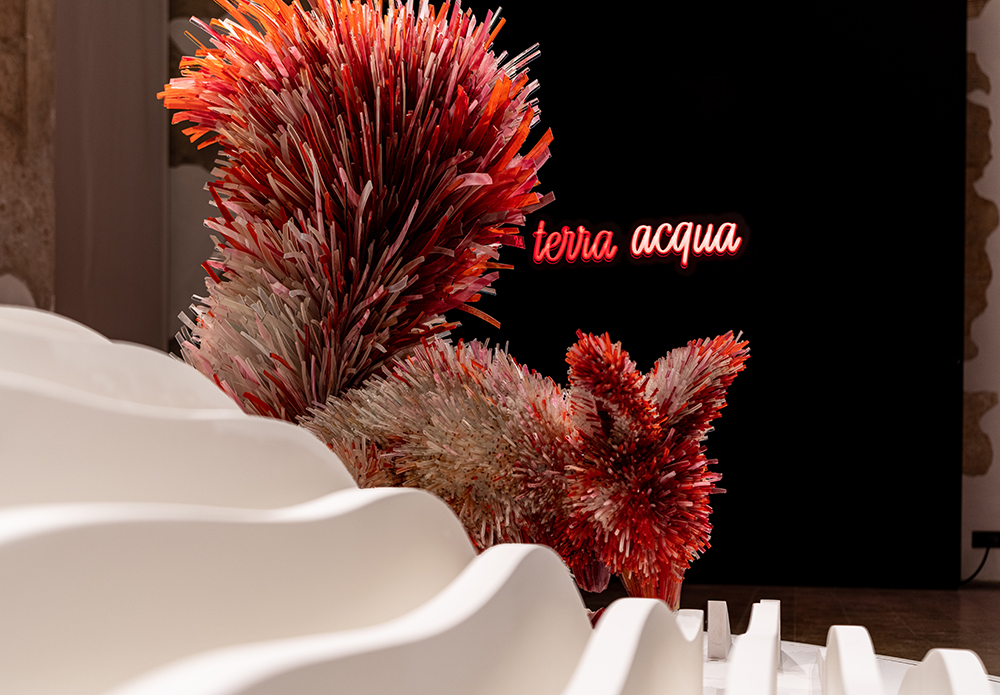
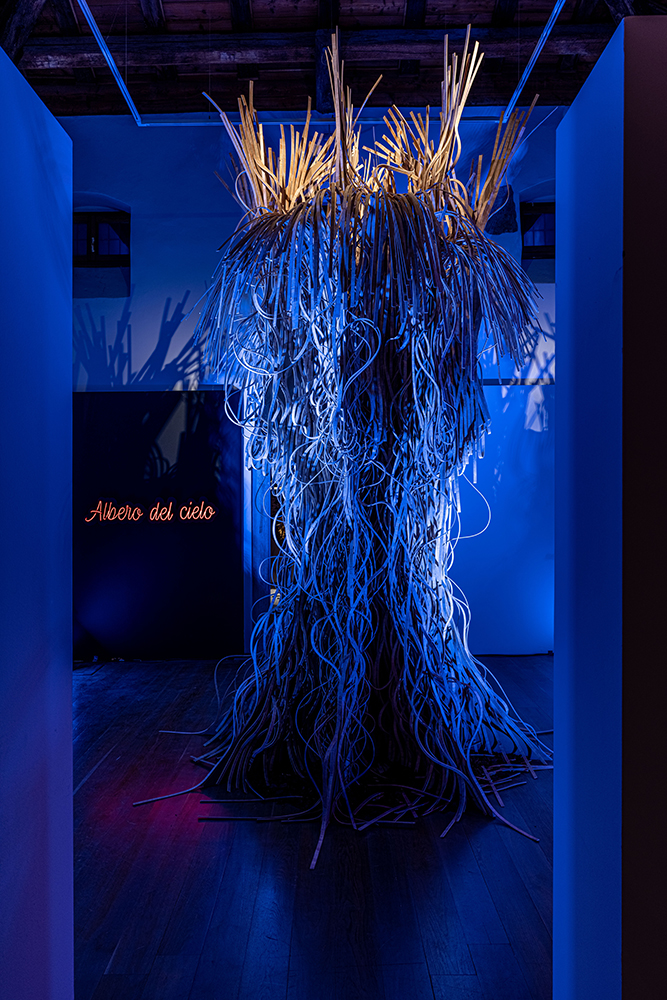
The world is a vast, living organism, from which differences arise, bound together by a universal soul—the soul of the world. Everything is in perpetual rotation, and in the carousel of life, opposites chase each other, pursue one another, sometimes one prevailing over the other, but never nullifying or eliminating each other. Everything ends, everything begins anew. And these differences generate energy and creativity within the ever-turning kaleidoscope, propelled by the soul of the world.
Stefano Zecchi
ANIMA MUNDI
The Carousel of Life
Palazzo delle Albere – Museum of Sciences of Trento
July 13th – October 29th, 2023
regulat ticket €7
Tuesday – friday 10 am – 6pm
Saturday, sunday and public holidays 10am -7pm
Monday: closed
t. 39 0461 270311
E-mail museinfo@muse.it
Koen Vanmechelen is one of the world’s most renowned multidisciplinary artists. Painter, sculptor, performer, and eclectic Belgian figure whose interests range from anthropology to bioethics, human rights to bio-genetics, he focuses his research on the concepts of hybridization (of animal and plant species) and contamination (of expressive techniques and materials). His fantastical artistic creatures were exhibited in 2022 at the Uffizi Gallery in Florence, alongside works by Leonardo, Raphael, and Michelangelo. The monumental work “Carousel of Life – La Giostra della Vita,” created in collaboration with Berengo Studio, incorporating Venetian glass, bronze, gold leaf, photographic prints, Venetian mirrors, wood, fabrics, steel, neon, and lights, almost becomes a symbol of the exhibition.
“The spinning carousels,” writes Koen Vanmechelen, “create a sense of perpetual motion that symbolizes the balance of biocultural diversity in the world. This installation celebrates the diversity and creativity of life, reminding us that life is constantly evolving and that we can achieve extraordinary things when we come together to celebrate our differences.”
Sebastian Brajkovic is an accomplished cabinetmaker, sculptor, and painter, even before becoming a designer. His work resides in the permanent collections of institutions such as the Victoria and Albert Museum in London, the Museum of Fine Arts in Houston, and the Museum of Arts and Design in New York. With a Dutch-Indonesian mother and a Croatian-Italian father, he has been drawn to rotating forms and constant contradictions since childhood.
“When I am attracted to function, I consider the deconstruction of that function. When I convey movement, it is best explained through stillness. The juxtapositions reveal each other’s aspects.”
Thanks to Berengo Studio, the artist showcases a glass and light artwork titled “Forme Informe,” which rotates in the carousel room. The glass recalls how rays of light traverse the sky, break, and reassemble, transforming and shaping archetypal forms into new geometries, almost molding matter into the invisible geometries of the universe.
Marta Klonowska Polish glass artist merging reality and imagination, representing life and reflecting on the relationship between humans and nature. The carousel “Terra Acqua”, with its exemplary glass craftsmanship by Berengo Studio, is telling us a story of matter, transparencies, lights, and carvings, the encounter of opposing elements the elusive force from the sea of life.
“I create installations that should transport the audience into a new universe. My glass animals open up a new reality, different from our own. They perform on a kind of theatrical stage. This clash of realities should make us reflect on the uncertainties of life.”
Marcello Pietrantoni, known for his bizarre, mysterious, ironic, and cruel sculptures, creates an invented mythology rooted in classicism. These elements come together in the carousel titled “Origine Divenire.” With his artistic research focused on the exploration of the human body and archetypes, myth takes on a central role. His bronze sculptures on display effectively convey the transcendent nature of transformation.
Sebastian Brajkovic is an accomplished cabinetmaker, sculptor, and painter, even before becoming a designer. His work resides in the permanent collections of institutions such as the Victoria and Albert Museum in London, the Museum of Fine Arts in Houston, and the Museum of Arts and Design in New York. With a Dutch-Indonesian mother and a Croatian-Italian father, he has been drawn to rotating forms and constant contradictions since childhood.
“When I am attracted to function, I consider the deconstruction of that function. When I convey movement, it is best explained through stillness. The juxtapositions reveal each other’s aspects.”
Thanks to Berengo Studio, the artist showcases a glass and light artwork titled “Forme Informe,” which rotates in the carousel room. The glass recalls how rays of light traverse the sky, break, and reassemble, transforming and shaping archetypal forms into new geometries, almost molding matter into the invisible geometries of the universe.
Sergio Boldrin is a master painter and mask maker with two renowned workshops in Venice, which he manages with his brother Massimo. The workshops are also famous for their collaboration with theater and cinema, particularly for creating masks for Stanley Kubrick’s film “Eyes Wide Shut.” Boldrin has exhibited his creations in Italy and internationally, in cities like London, Paris, New York, and Los Angeles. His presence in the exhibition highlights the significance of craftsmanship and ancient professions in our modern era. Sergio Boldrin’s carousels bring to life the contrasts of nature and life through universal symbolic images, such as “Angels Demons,” “Sun Moon,” “Life Death,” and “Health Illness.” These works are crafted from raw materials like clay, plaster, papier-mâché, gold, and oil paint.
“One day the Master said: I will tell you the story of this marvelous beauty. The Apprentice replied: Why do you speak in a low voice? The Master answered: Because the craft of Master artisans is passed down from father to son, keeping the alchemy of their art undisclosed. And the secret of creating objects, each one unique and unrepeatable.” Like the mystery and alchemy of the created works.
Along the exhibition path in the room of opposites, “Luce Tenebra” (Light Darkness) illuminates, the first of the two installations created by Architect Silvio De Ponte | De Ponte Studio Architects.
“A suggestive cloud suspended in space, woven with brass fabric – explains Silvio De Ponte – creates fading play of light and shadow. The carousel dematerializes and floats in the air amidst reflections and shadows.”
Between earth, water, light, and air, the life of the soul of the world infuses into the grand “Albero del cielo” (Tree of the Sky). “The cyclicality of nature, osmosis, and dynamism – continues De Ponte – shape the form with a fluid progression through the overlapping shapes of birch wood and video projections.”
An installation born from the idea of the exhibition curator, Beatrice Mosca:
“In Chinese mythology, Nüwa is the female deity of creation and also the maiden who saves the world from a great flood by climbing up to stitch the sky. The tree is a symbol of life but also of the universal connection between earth and sky, the cosmic soul of the world. On the second floor of the Palazzo, the exhibition concludes with the reintegration of the one into the whole.”
WORDS OF LIGHT
The illuminated rooms
Bibliography | Sources
Everything goes, everything returns; the wheel of being forever turns. Everything dies, everything blossoms again. The year of being forever runs. Curved is the path of eternity. Friedrich Nietzsche
The soul is the greatest of all miracles of nature, its center, the continuity of the world, the face of everything, the bond and coupling of the universe. Marsilio Ficino
What is opposite is reconciled, from things in contrast arises the most beautiful harmony, and everything is generated through contention. Heraclitus
To be One with the Whole, this is the living of the gods, this is heaven for man. There shall be one beauty, and humanity and nature shall merge into a universal divinity. Friedrich Hölderlin
Don’t you sense in my songs that I am both one and double? Soul of the world, come, infuse yourself within us! Johann Wolfgang von Goethe
Long deceived, now transformed, we flee swiftly like Nature, we are Nature, long have we been absent, but now we return, we are two in one, we are darkness, we are oaks, we are every influence of the globe, we have rotated and rotated until we have come home again, the two of us. Walt Whitman
All things eternally return, and we with them, and we have already been, eternal times, and all things with us. Friedrich Nietzsche

